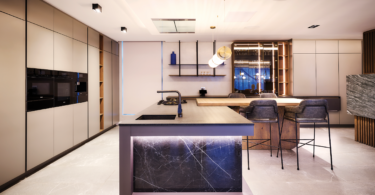Use energy sparingly in the kitchen and save money while you’re at it…
1 Keep your oven doors completely closed while cooking, as the temperature drops every time the door is opened and the heat then needs to be replaced.
2 Use pots and pans with flat bases that completely cover the stove plates while cooking. Also make sure that they have tight-fitting lids and that they don’t touch each other during cooking (this goes for inside the oven too). If you have a stove with heavy, solid plates that retain heat well, switch off the plate just before the end of cooking and use the residual heat to finish the cook.
3 Use a pressure cooker to conserve energy when cooking foods that take a long time, such as casseroles and stews.
4 You can save a lot of energy by concentrating light just where you need it. For instance, install a track of LED under-counter lights to illuminate your food-prep area or hang task lighting directly above your kitchen island.
5 Only fill and boil the kettle with as much water as you need. The most energy-saving kettles have a low minimum-fill line and they will switch off quickly after boiling. Descale your kettle regularly too, because if it is full of lime-scale it will use more electricity to boil the same amount of water.
6 Always fully load your dishwasher, washing machine and tumble dryer, as partial loads waste electricity and water. Set them on the most energy-efficient cycle (most domestic appliances nowadays have some kind of ‘eco cycle’ designed to cut electricity and water use).
7 Use cold water where possible for washing clothes and clean the lint filter every time you use the tumble dryer, as a blocked filter stops the hot air from circulating freely, so clothes take longer to dry.
8 Make sure that the seal around your fridge door is intact (test this by closing the door on a sheet of paper – if you can pull the paper out easily, the seal needs to be replaced). Also, every time you open your fridge door it loses cold air and cooling it down again uses electricity. So be quick and don’t let all that cold air out (quick tip: label leftovers so you can quickly see what they are).
9 Skip the ice-maker and water-dispenser when buying a fridge. They may appear convenient in that they reduce the need to open the door, but they actually increase a fridge’s energy use and they’re usually more expensive too.
10 Avoid putting warm food in the freezer – it just makes it work harder. Rather allow food to cool down first. Also, defrost frozen food in your fridge. It will act like an ‘ice pack’ to help cool the fridge, thereby reducing the amount of electricity the fridge needs to use to keep cool.
11 Don’t park your fridge near a heat source like an oven, dishwasher or even direct sunlight from a window. It will have to work that much harder to maintain cool temperatures. If you must install a dishwasher or stove next to the fridge, place some insulation (like a sheet of foam) between them.
12 A full fridge retains cold better than an empty one. If your fridge is nearly empty, store bottles of water inside. The mass of cold items will help the fridge recover more quickly after the door has been opened. Take care not to overfill it though, as it will interfere with the circulation of cold air inside. The simplest solution is to buy the right size fridge to suit your family’s needs in the first place. And get rid of that old, energy-guzzling second fridge or freezer in the garage.
13 To save electricity when ironing, iron low-temperature fabrics first to reduce warm-up time; iron large batches of clothing at one time to avoid wasting energy reheating the iron several times over; switch your iron off before you are finished and complete the ironing on stored heat, and iron only what you absolutely have to (no-one cares if you go to bed in wrinkled PJs).
14 This is always listed as a water-saving tip, but you will save on electricity too if you fix any dripping hot-water taps.
15 Faulty appliances can waste a lot of electricity, so repair or replace them. Also, turn appliances like coffee machines off at the wall plug, rather than leaving them on standby mode where they can still draw power.











Leave a Comment